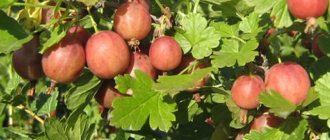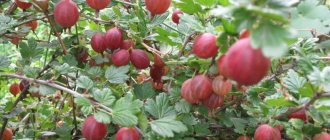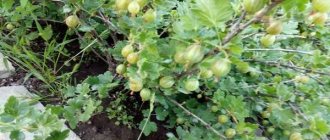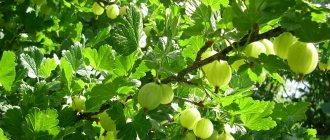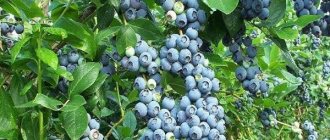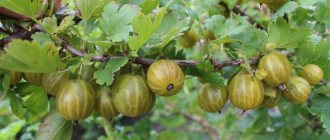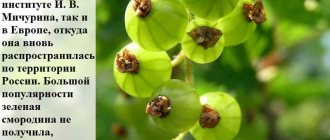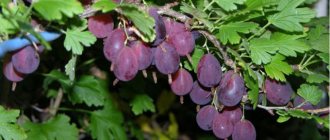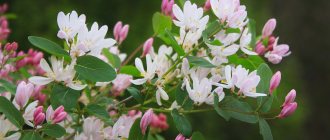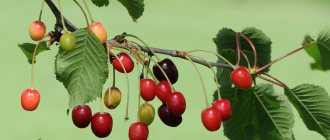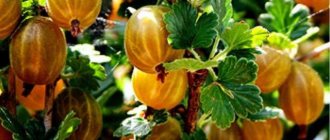The main differences between thornless gooseberries
Varieties differ in the shape, size and color of the berries, and taste: some are sour, others are sweeter. But all non-thorny and low-thorn varieties of gooseberries are characterized by common characteristics, they are:
- are not susceptible to fungal disease in the form of a white coating on the leaves (powdery mildew), especially Grushenka and Northern Captain;
- cold-resistant, do not freeze out in harsh winters, tolerate short-term frosts well;
- light-loving, bloom more actively in well-lit areas;
- high-yielding: on average, low-thorn and non-thorny varieties are 20-30% more productive than others.
Dark thornless varieties of gooseberries are very useful. In terms of chemical composition, they are richer than green and red varieties. Dark gooseberries contain more:
- vitamin P, which strengthens vascular walls;
- pectin, which promotes digestion;
- ascorbic acid (2-4 times), which increases the body’s protective functions;
- trace elements: copper, selenium, zinc and others.
Follow-up care for gooseberries
Thornless gooseberries require attention in terms of care. Even increased resistance to some negative factors will not save the crop from death if the bush is left unattended.
Basic plant care procedures:
- Perform periodic watering (once a week).
- Loosen the soil around the trunk after each watering.
- Carry out formative pruning every year.
- Feed the crop based on the age of the bush.
Gooseberry care
Important! After planting, you can start caring for the plant only in the spring.
Northern captain
This popular variety is characterized by clusters of up to 4 oval berries each with medium-thick skin. On the lower branches there are single thorny shoots, on young ones they are practically absent. Almost black berries with a bluish waxy coating grow up to 4 grams, the taste is pleasant, moderately sweet, with a slight tartness and slight sourness.
Read here - Industrial hemp
The berries are great for homemade preparations and wine. Productivity up to 12 kg from one developed two-year-old bush. Does not take root well on soils with high groundwater levels.
General advantages and disadvantages of thornless gooseberries
Black gooseberries - growing at home
Like any selected species, the plant has the best qualities, but it also has flaws. Thornless gooseberries have the following advantages:
- The bush is easy to process; harvesting is not complicated due to the absence of thorns.
- Basically, all varieties are frost-resistant and immune to standard gooseberry diseases.
- High yield is combined with good taste.
Negative aspects of the plant:
- Gooseberries are not thorny along the branches, but thorns are present on the trunk at the pre-root part.
- The shrub requires more careful pruning, since the above-ground part is usually quite large and spreading.
- The berries are not always large.
Drought resistance, frost resistance
Thornless gooseberries, the varieties of which are more popular, are resistant to low temperatures. Some of them also tolerate hot, dry weather well. If any problems arise due to unfavorable climatic conditions, with proper care they can be quickly resolved.
Productivity and fruiting
Selected types of crops give an excellent harvest, which can range from 5 to 15 kg from one average bush. The berries are usually evenly distributed along the branches and can be formed in clusters of 2-3 fruits.
Productivity
The ripening of each type is determined individually, but usually in mid-June or early August you can taste ripe berries.
Area of application of fruits
Selected gooseberries have a huge scope of application. The taste and aroma make the berries of the plant universal for any type of processing. Gooseberries combine wonderfully with any berries and fruits.
Possible methods of consumption, cooking and preservation:
- cooking preserves and jams;
- making wine;
- fresh consumption;
- canning compotes.
Additional Information. Thornless gooseberry varieties are well transported due to the presence of dense skin. Some species do not fall off for a long period after ripening.
Resistance to diseases and pests
Selected gooseberry varieties are immune to many diseases and pests standard for the crop:
- powdery mildew;
- anthracnose;
- septoria;
- fungal diseases;
- spider mite;
- fire
Sustainability
This makes the plant more popular among gardeners, since in most cases the harvest is lost precisely because of such common diseases.
African
The African reaches a height of 1.2 meters. Slightly elongated dark purple berries are medium-sized. The taste is reminiscent of sweet currants. Winter-hardy variety, resistant to shedding, brushes stay on the branches for a long time. Gooseberries have practically no thorns.
To preserve the harvest during periods of high humidity, the bush is treated for preventive purposes with biological products against anthracnose - cinnamon rot. Plants do not develop well in dense plantings. Medium spreading bush, loves space.
Rules for planting gooseberries
Why gooseberries don’t bear fruit: what to do and how to make them bear fruit
In order for the plant to take root normally and develop in the future, it is worth making high-quality planting. There are several basic conditions that must be met when planting the presented crop.
Planting gooseberries
Recommended timing
The best time for planting is the end of September or the beginning of October. They mainly focus on weather conditions. Particular attention should be paid to early frosts. If this option is possible, then it is better to plant the bushes in mid-September.
Note! You should not plant in the spring, as the bush may take a long time to take root and not take root at all.
Choosing a suitable location
The choice of location is a priority for planting gooseberries. It is necessary that the bush is located 50 cm from the fence or other buildings. The area should be well lit. The presence of drafts and shade can affect the development and timing of berry ripening.
Place to plant a bush
Selection and preparation of planting material
In order for the plant to bear fruit well in the future and develop well, you need to choose suitable planting material. A thornless bush must meet the following requirements:
- The seedling must be undamaged, the root and its shoots must be “alive”.
- Using the pruning method, you need to leave no more than 5 branches on the bush.
- There should be no insects or mechanical damage on the buds and trunk.
- The branches should be of medium thickness.
Shrub pruning
Landing algorithm
- Dig a hole 60 cm deep, with sides 40 cm.
- Pour 10 liters of humus, mineral fertilizers and 50 g of wood ash into the hole.
- Stir the mixture until smooth.
- Place the seedling in the hole, cover it with soil, and compact the soil around the trunk.
- Water thoroughly.
Additional Information! The filling for the hole can be prepared in a separate container and then poured into the hole.
Eaglet
The thornless gooseberry of the Eaglet variety is beautiful. This is the earliest ripening species. The bush is medium-sized, not spreading, yield up to 7 kg. It rarely throws out thorns; they fall off in the fall.
The skin of the berries contains a large amount of coloring pigment, which is not destroyed by heat treatment. The color of ripe berries is dark purple; when sugar is added, they acquire a rich ruby color.
Diseases and pests, methods of control and prevention
Depending on the conditions of their maintenance, thornless varieties of gooseberries, despite their resistance, may be subject to invasion by pests or diseases. Main diseases and parasites:
- anthracnose Characterized by the appearance of brown spots of irregular shape. They are scattered across all the leaves, and over time they begin to flow in. To combat anthracnose in early spring, the soil around the plant is sprayed with 1% copper sulfate. You can use colloidal sulfur. It is diluted in a proportion of 30 g per 10 liters of water;
- Goblet rust occurs on leaves and fruits. Resembles spots in the form of orange glasses. The fight against goblet rust is carried out by spraying the bushes before the flowering period and after picking the berries. The disease is treated with copper oxychloride in a ratio of 40 g per 10 liters of water;
- aphid. Manifests itself in the form of curling leaves at the ends. As a rule, young shoots are affected. To destroy and prevent the appearance of aphids, treat with 3% karbofos or soap solution;
- The gooseberry moth is a parasite that damages berries. They begin to ripen early and turn red. The entire bunch of berries may be covered with cobwebs, and one of the berries may contain a pest - a caterpillar. When dealing with this parasite, you need to be patient. Collection is carried out manually, destroying the caterpillars. As a preventative measure in the autumn, it is necessary to hill up the soil around the bush. Before the beginning of the flowering period and after it, spraying with karbofos is carried out.
Variety Emerald
Gooseberries and, in particular, their fruits take their place of honor among berry lovers. The fruits of the plant have a whole range of useful microelements and vitamins. But harvesting from the bush is a problem, since each branch has tenacious thorns. Through crossbreeding, breeders obtained gooseberry varieties that lacked a large number of thorns.
Important! There are no completely thornless varieties.
Thornless varieties of gooseberries do not differ at all from thorny ones in terms of planting principles and resistance to frost (it all depends on the area). The taste of the berries also did not undergo any significant changes during selection. Therefore, each gardener decides for himself whether to buy seedlings of these species or not.
Bright red colors of berries
Among the varieties of thornless gooseberries, there are varieties with red berries of various shades from rich burgundy to cherry. In the middle zone, several varieties are most common:
Lights of Krasnodar - medium spreading bush; Small round berries at the stage of ripeness acquire a red-burgundy color, sweet and sour, slightly tart.
Kolobok is the fastest growing bush, annually throws out many shoots, requires regular pruning, the taste of the berries, the color of ripe cherries, is average, they are ideal for processing and preparation.
Vladil is a very disease-resistant gooseberry that bears fruit consistently regardless of weather conditions; The berries are cherry-red, moderately sour, small in size, with thin but dense skin.
- Operation of a piston compressor
- Garden equipment from - features and benefits
Plant nutrition
Sirius is especially common in the southern regions, the drought-resistant variety is not prone to shedding, the berries are dark red with greenish streaks, average size up to 4 g.
Grushenka forms paired clusters, berries of an unusual shape for a gooseberry, the bush ripens unevenly: on the southern side, the upper part turns red a week earlier.
Varieties that are suitable for central Russia
Unfortunately, not all varieties of thornless gooseberries take root and bear fruit in the conditions of central Russia. But thanks to scientists, berry bushes have been developed that are adapted to the necessary climate conditions.
Grushenka
Frost-resistant gooseberry variety with purple berries weighing up to 5 g, pear-shaped. The main feature of the fruit bush is very rare spines on the shoots.
The variety easily tolerates spring frosts and has increased immunity to fungal infections and pests. One bush produces up to 6 kg of ripe berries.
Russian yellow
Russian yellow variety of medium ripening period. The first berries appear in mid-July. The fruits are large, up to 5.5 g, elongated, yellowish-greenish in color with sweet, juicy pulp.
The berry crop is resistant to low temperatures and some diseases. Although the variety is recommended as thornless, there are thorns on the bushes, but they are concentrated deep in the crown of the plant.
Amber
One of the most proven gooseberry varieties, bred in the middle of the last century. A tall berry bush with a spreading crown and sparse but very sharp thorns.
The berries are large, up to 5 g, beautiful amber in color with a sweet taste.
The fruit crop is resistant to frost and some diseases. From one plant you get from 7 to 10 kg of ripe berries.
Kolobok
Tall, spreading berry bush, there are practically no thorns on the shoots, medium ripening period. Dark red, large up to 7 g, sweet and sour berries ripen by mid-July.
The variety easily survives winter frosts, but reacts painfully to sudden temperature changes. Also, gooseberries of the Kolobok variety do not tolerate prolonged drought.
Sirius
A compact fruit shrub grows up to 1 m. Ripe berries are large, sweet, weighing up to 5 g, cherry in color. The variety is resistant to frost, spring frosts, fungal infections and pests.
The main advantage of the Sirius gooseberry is its rare thorns on the shoots, which do not pose a danger during plant care and when harvesting berries.
Chelyabinsk
Chelyabinsk gooseberries have earned popularity for the unusual color of the fruit, high yield and a small number of spines located deep in the crown of the plant.
The variety is resistant to low temperatures and diseases, which makes it possible to grow fruit shrubs even in northern climates.
Nuances of growing and care
To successfully cultivate thornless gooseberries and obtain a bountiful harvest, it is necessary to choose the right place, prepare it for planting and follow the agricultural practices of planting and growing.
Selecting a location:
- Sunny or with some shade during the day.
- No drafts.
- Eastern, southern side of the site.
Seat:
- Soil: black soil, sandy loam, loamy. Wetlands and areas with high acidity are not suitable.
- pH level 5.2-6.7.
- In the new place, all weeds are removed, the soil is dug deep and loosened so that the soil is softer, lighter, and more breathable. Sand and peat can be added to clay soils.
See also
Description and characteristics of the Malachite gooseberry variety, planting and careRead
It is better to select a seedling in a nursery:
- The seedling can be one, two, or three years old.
- Healthy, without obvious signs of disease, damage by rodents or other pests, rot, or breakage.
- Leaves are rich green.
- The root when cut is white, flexible, elastic.
Boarding time:
- Autumn, end of September - first half of October in the middle zone, in the south, southwest, southeast, in the Moscow region.
- Spring, April - first ten days of May: northern regions, the Urals, Siberia.
Stages of planting gooseberries without thorns:
- For a day, place the seedlings in a bucket of water or diluted growth and root formation stimulator.
- Mark the planting pattern on the prepared area. The distance between rows is 1.5-2 m, between bushes 1.3-1.5 m.
- The pit is 35-45 cm deep, diameter 35-50 cm.
- If the soil is heavy and underground water is close, then dig a hole to a depth of 50 cm, lay a layer of expanded clay or broken brick drainage on the bottom, and sprinkle a layer of sand on top.
- If the soil is black soil or loam, then water the hole with 4-6 liters of water before planting the seedling.
- Then, up to 100 g of nitroammophoska is poured into the hole under the bush.
- The seedling is buried no more than 4 cm from the root collar. If planted deeper, the root will grow higher, since gooseberries reproduce vegetatively.
- Sprinkle it with a mixture of soil, ash, and rotted manure.
- Leave a hole around the bush to retain water.
- Water the hole with 5-6 liters of water.
- Mulch the top with rotted manure and pine needles if planting took place in the fall.
Caring for the bushes is simple, watering 10-12 liters per bush once every 2-3 weeks. During the period of berry ripening, irrigation is stopped.
Feeding after planting with fertilizers is carried out after 1.5-2 years. In spring, you can use fertilizers with nitrogen, phosphorus, and potassium. During the flowering period, urea or infusion of weeds. In the fall, mulch the soil around the gooseberries with peat, manure, and ash. In summer and autumn, the soil around is mulched in the form of fertilizer with mowed green manure, which has a positive effect on the growth and fruiting of bushes.
Pruning is carried out in the fall to form new shoots during the growth period in the spring. Cut the skeletal branches into 1-2 buds facing the inside of the bush if the branches droop inside the bush. If the branches are erect, then cut off 1 outer bud.
In the spring, formative pruning is carried out before the active growing season begins; growths and branches that thicken the bush are trimmed with pruning shears. Every 8-10 years you need to carry out anti-aging pruning, cutting off all old shoots.
Thornless gooseberry varieties are almost not attacked by insects and rodent pests and various diseases, but in spring and autumn they require preventive spraying with fungicides and insecticides.
Description of the bushes
Gooseberries grow as bushes. Its height can reach one hundred and twenty centimeters. The bark of the plant is gray-brown in color and has spines, the origin of which is leafy. And on the cylindrical young shoots you can find thin thorns. There is also a thornless gooseberry, the planting and care of which will be discussed in more detail below. The leaves of the plant reach a length of six centimeters and have a round shape. The flowers bloom in May and are distinguished by a reddish or greenish tint. The fruits are oval-shaped, smooth or covered with small bristles. Usually their size reaches twelve millimeters, but there are specimens in which the berries grow up to forty millimeters.
Fruit ripening occurs in July or August. They can be green, yellow, red and even white in color. The berries are very healthy because they contain organic acids and salts of many metals. Gooseberries are a self-fertile crop. This means that even one bush in the garden will regularly bear fruit for many years.
